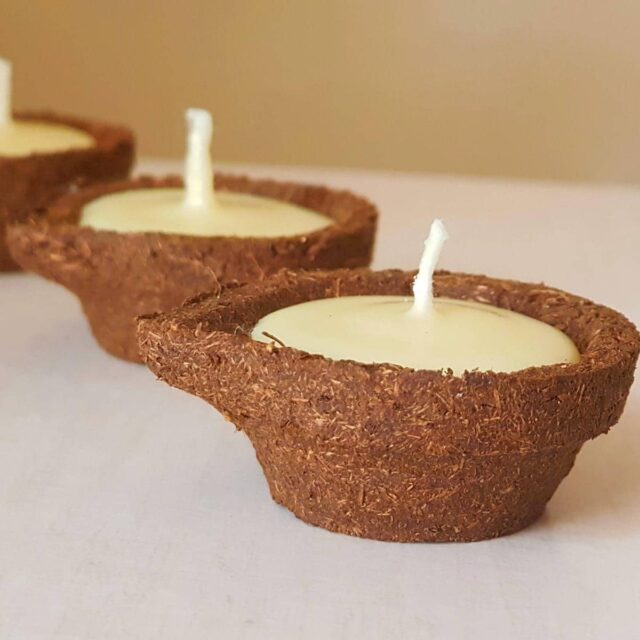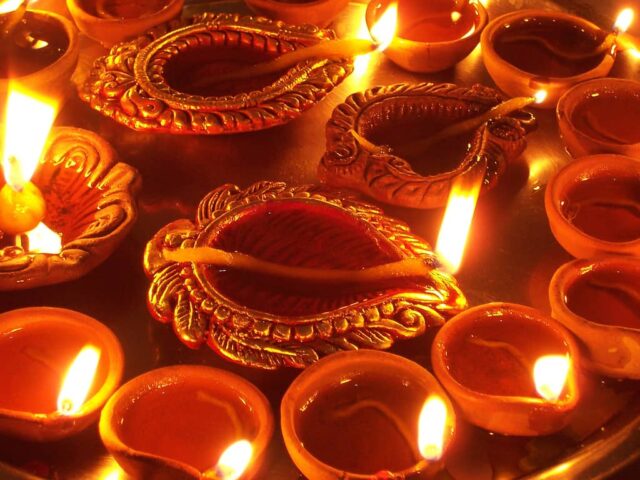India has a unique relationship with its most favourite animal, the cow. It is a sacred animal for the Hindu community, who worship and revere it as part of their culture. India has also had its fair share in politicising this humble animal, but this article will not focus on that aspect.
In a great turn of events, the National Cow Commission, also known as the Rashtriya Kamdhenu Aayog, which was set up in 2001 to improve the condition of cattle in India, has announced that it will manufacture around 33 crore diyas made out of cow dung for this Diwali!
We’ll describe to you how you can spot and buy one for this year’s festival!

Kamdhenu Deepawali Abhiyan
We are well aware of the polluting and harmful nature of firecrackers, and its disheartening relationship with child labour in India. While spreading awareness, we have always requested people to opt for a better alternative which is the use of diyas.
However, diyas are now upping their environmental game.
The chairman of the Aayog, Vallabhbhai Kathiria, had mentioned that he would start a nationwide campaign to promote the use of cow dung diyas with a broader goal to stop the purchase of Chinese diyas.
He also said that this initiative would make India ‘Atma Nirbhar’ and contribute to the Prime Minister’s vision of ‘Make in India.’
Read More: Why Are Scientists Planning To Paint Large Eyes On The Backs Of Cows?
This campaign is an extension of the successful Gaumaya Ganesha Campaign which had encouraged people to use Ganesha idols made out of cow dung for the Chaturthi festival.
Around 15 states have agreed to be part of this campaign as of now.
How Do They Look?
Here’s a sneak-peek into what these diyas look like.

They come either in dark brownish-green or dark brown colours and have a rough texture on the outside. They are weightless and are not that costly as well.
They can be reused as manure after the festival! And of course, they are odourless. These diyas will be available in local markets and one can even find them now on various websites.
An Answer To Livelihood
Apart from the protection of cows, the Aayog also gives a lot of emphasis on generating better livelihood for cattle farmers. It has been trying to improve the average milk yield of India and has also tapped into the eco-friendly potential of cow dung as a resource.
According to the commission, around 192 crore kg of cow dung is produced in India every day. Another study conducted by the International Labour Organisation found that the informal economy surrounding cow dung is overlooked.
The productive use of cow dung can generate around 2 million jobs as well as women’s self-help groups.
In 2019, the women in Raipur, which is in Rajasthan, had fashioned many products out of cow dung such as idols, diyas, candles and mobile phone stands. It was part of the Garuva-Narva-Ghuruva-Badi initiative to encourage small businesses that used cow dung.
Reaping Environmental Benefits
The usage of cow dung will not just help us use that resource effectively, but will also significantly reduce the pollution that comes with the industrial production of diyas. Terracotta diyas have been known to contribute towards soil erosion.

Animal waste is usually considered pollutive because of the methane and phosphorus gas that comes out of it, but a productive conversion of it into other products can be a huge conservation of other resources. As they say, it’s best out of waste!
Various countries have taken such an initiative for better disposal or use of animal waste. The University of Vienna teamed up with European farmers to convert animal waste into paper!
Waiting For A Better Diwali
This particular initiative also extends to other products such as anti-radiation chips. The chairman’s goal is to rejuvenate informal economies in rural India and create job opportunities during the coronavirus pandemic.
If India could use these and also give up on firecrackers, we could celebrate an environmentally sustainable Diwali this year. That would be at least one piece of good news in 2020!
Image Credits: Google Images
Sources: The New Indian Express, Mirror Now News, The Indian Express
Find the Blogger: @aiswaryanil
This post is tagged under: diwali, where to buy diyas for diwali, deepawali, cow protection in india, cow worship in india, bio gas plants, environmental benefits of cow manure, uses of cow dung, what can be done with cow waste, rural livelihood, how much cow dung is produced and used in india, informal sector of india, why is diwali celebrated in india, potential of cow dung industry in india. make in india, aatmanirbhar bharat, indian local markets, indian women, self help groups, women in raipur, what is the kamadhenu deepawali abhiyan, what damage does terracotta do to the environment, animal waste disposal, how to not use chinese goods, indian labour organisation and what does it do
Other Recommendations:
A Bizarre Theft Again Happened, Nearly 100 Kg Of Cow Dung Stolen From Chhattisgarh
































